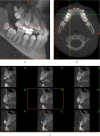The current status of cone beam computed tomography imaging in orthodontics
- PMID: 21159912
- PMCID: PMC3611465
- DOI: 10.1259/dmfr/12615645
The current status of cone beam computed tomography imaging in orthodontics
Abstract
Cone beam CT (CBCT) has become an increasingly important source of three dimensional (3D) volumetric data in clinical orthodontics since its introduction into dentistry in 1998. The purpose of this manuscript is to highlight the current understanding of, and evidence for, the clinical use of CBCT in orthodontics, and to review the findings to answer clinically relevant questions. Currently available information from studies using CBCT can be organized into five broad categories: 1, the assessment of CBCT technology; 2, its use in craniofacial morphometric analyses; 3, incidental and missed findings; 4, analysis of treatment outcomes; and 5, efficacy of CBCT in diagnosis and treatment planning. The findings in these topical areas are summarized, followed by current indications and protocols for the use of CBCT in specific cases. Despite the increasing popularity of CBCT in orthodontics, and its advantages over routine radiography in specific cases, the effects of information derived from these images in altering diagnosis and treatment decisions has not been demonstrated in several types of cases. It has therefore been recommended that CBCT be used in select cases in which conventional radiography cannot supply satisfactory diagnostic information; these include cleft palate patients, assessment of unerupted tooth position, supernumerary teeth, identification of root resorption and for planning orthognathic surgery. The need to image other types of cases should be made on a case-by-case basis following an assessment of benefits vs risks of scanning in these situations.
Figures






Similar articles
-
Cone beam CT in orthodontics: the current picture.Int Orthod. 2013 Mar;11(1):1-20. doi: 10.1016/j.ortho.2012.12.011. Epub 2013 Feb 1. Int Orthod. 2013. PMID: 23375864 English, French.
-
Cone beam computed tomography: a useful tool in orthodontic diagnosis and treatment planning.J Orthod. 2009 Sep;36(3):202-10. doi: 10.1179/14653120723193. J Orthod. 2009. PMID: 19741183
-
CBCT in orthodontics: assessment of treatment outcomes and indications for its use.Dentomaxillofac Radiol. 2015;44(1):20140282. doi: 10.1259/dmfr.20140282. Dentomaxillofac Radiol. 2015. PMID: 25358833 Free PMC article. Review.
-
Cone beam computed tomography--current understanding and evidence for its orthodontic applications?J Orthod. 2013 Mar;40(1):5-13. doi: 10.1179/1465313312Y.0000000040. J Orthod. 2013. PMID: 23524542 Review.
-
Practical applications of cone-beam computed tomography in orthodontics.J Am Dent Assoc. 2010 Oct;141 Suppl 3:7S-13S. doi: 10.14219/jada.archive.2010.0361. J Am Dent Assoc. 2010. PMID: 20884934
Cited by
-
Comparison of lateral photographic and radiographic sagittal analysis in relation to Angle's classification.J Orofac Orthop. 2015 Jul;76(4):294-304. doi: 10.1007/s00056-015-0292-6. J Orofac Orthop. 2015. PMID: 26123731
-
Application of digital positioning guide plates for the surgical extraction of multiple impacted supernumerary teeth: A case report and review of literature.World J Clin Cases. 2022 Sep 26;10(27):9886-9896. doi: 10.12998/wjcc.v10.i27.9886. World J Clin Cases. 2022. PMID: 36186207 Free PMC article.
-
Hallmark of success: top 50 classics in oral and maxillofacial cone-beam computed tomography.Pol J Radiol. 2018 Jan 20;83:e11-e18. doi: 10.5114/pjr.2018.74343. eCollection 2018. Pol J Radiol. 2018. PMID: 30038673 Free PMC article. Review.
-
Comparison of two three-dimensional cephalometric analysis computer software.J Orthod Sci. 2014 Oct;3(4):111-7. doi: 10.4103/2278-0203.143230. J Orthod Sci. 2014. PMID: 25426454 Free PMC article.
-
The effect of root and bone visualization on perceptions of the quality of orthodontic treatment simulations.Angle Orthod. 2017 May;87(3):384-390. doi: 10.2319/082416-634.1. Epub 2016 Nov 22. Angle Orthod. 2017. PMID: 27874283 Free PMC article.
References
-
- Shortliffe E, Perreault LE, Wiederhold G, Fagan LM. Medical informatics: computer applications in health care and biomedicine. 2nd edn. New York: Springer;2001
-
- Tsao DH, Kazanoglu A, McCasland JP. Measurability of radiographic images. Am J Orthod 1983;84:212–216 - PubMed
-
- Adams GL, Gansky SA, Miller AJ, Harrell WE, Jr, Hatcher DC. Comparison between traditional 2-dimensional cephalometry and a 3-dimensional approach on human dry skulls. Am J Orthod Dentofacial Orthop 2004;126:397–409 - PubMed
-
- Harrell WE., Jr 3D Diagnosis and treatment planning in orthodontics. Semin in Orthod 2009;15:35–41
-
- Harrell WE, Jr, Hatcher DC, Bolt RL. In search of anatomic truth: 3-dimensional digital modeling and the future of orthodontics. Am J Orthod Dentofacial Orthop 2002;122:325–330 - PubMed
Publication types
MeSH terms
LinkOut - more resources
Full Text Sources
Medical

